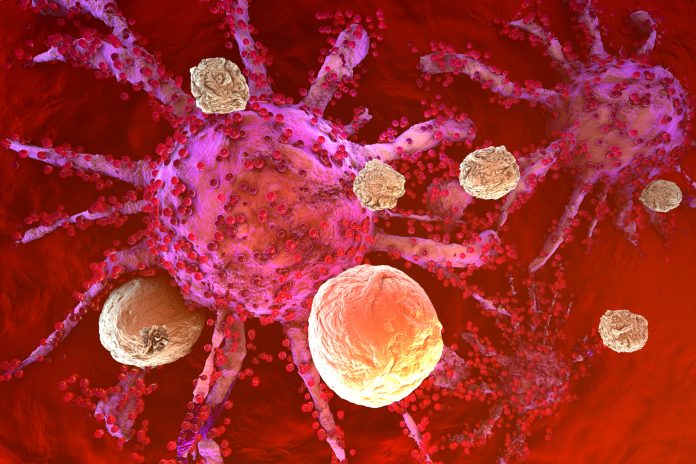
A preclinical study by Cleveland Clinic researchers reveals that the immune checkpoint protein VISTA can turn off tumor-fighting T cells during immunotherapy and resist treatment. The work using mouse models, showed that VISTA can bind to a protein called LRIG1 in T cells, which was previously only thought to promote bone and fat development. When VISTA binds to LRIG1, the researchers found, LRIG1 sends signals that suppress T cell replication, survival, and function.
This interaction can happen between molecules on tumor cells and on T cells, molecules on healthy cells and T cells, and even between molecules on the same T cell. The results suggest that blocking LRIG1 function can halt tumor growth in many cancers.
The findings follow on from another discovery by researchers in the lab of Li Lily Wang, PhD, at the department of translational hematology and oncology, which showed VISTA indirectly suppresses our immune systems by promoting cells called myeloid-derived suppressor cells (MDSCs) that are well known to block T-cell function.
“Our two discoveries combined create a paradigm that explains how VISTA can act as a ‘super villain’ that uses many different weapons to impair antitumor responses during cancer treatments,” said Wang. “This is an insight that drug developers need to consider if they want to boost treatment response rates to their full potential.”
The researchers reported on their latest work in Science Immunology. In their paper, the team concluded, “Here, we identified and characterized a T cell co-inhibitory receptor LRIG1 that interacts with VISTA, an established immune checkpoint protein …These results delineate the role of LRIG1 as an inhibitory immune checkpoint receptor and propose a rationale for targeting the VISTA/LRIG1 axis for cancer immunotherapy.”
Immune checkpoint inhibition (ICI) is a promising approach to cancer therapy, activating tumor immunity and improving the survival of patients, the authors explained. VISTA functions as a negative checkpoint regulator that modulates the immune responses of healthy cells to keep them from attacking our own bodies, protecting the body from autoimmune issues.
However, studies by a group led by Wang have shown that during immunotherapy, VISTA impairs immune activation and prevents T cells from attacking cancer cells. While researchers have worked to generate strategies for blocking VISTA from activation during immunotherapy, success has been limited because exactly how VISTA works hasn’t been known. “VISTA plays an important role in maintaining T cell quiescence,” the team stated, “… however, the molecular mechanisms through which VISTA regulates antitumor immunity are not well defined.” Previous studies, the team noted, “support VISTA as a potent regulator of antitumor immunity,” but its “elusive signaling mechanisms hinder the development of VISTA inhibitors with precise actions and prevent the identification of biomarkers related to VISTA biology.”
As part of their newly reported studies, Wang and colleagues discovered that LRIG1 acts as an inhibitory VISTA receptor. Their initial studies confirmed that LRIG1 was highly expressed in mouse and human T cells after T-cell receptor (TCR) activation. Murine studies indicated that LRIG1 acts as a T-cell inhibitory receptor that mediates the suppressive effects of VISTA in vivo. Further work then provided “strong evidence that LRIG1 impairs the expansion, survival, and effector function of tumor-specific CD8+ CTLs,” the scientists wrote.
When the team investigated LRIG1 expression in human cancer tissues, they found that in human melanoma and endometrial cancer, LRIG1 expression in tumor-associated T cells was correlated with resistance to immunotherapy. The results collectively supported the conclusion that “LRIG1 is a T-cell inhibitor receptor and that elevated LRIG1 expression in CD8+ T cells is associated with resistance to ICI therapies.”
Lead first author Hieu Minh Ta, PhD, said, “Studying the molecular aspect of how LRIG1 functions as VISTA’s receptor on T cells can provide insights on how to successfully block VISTA and improve the clinical outcomes of the patients who don’t respond to existing immune therapies.” Added study co-first author Dia Roy, PhD, “Our findings in human cancer samples inform and support the decision to go after LRIG1 as a potential drug target for new immune checkpoint therapies.”
The newly reported work was carried out as a collaboration between labs led by Wang and Timothy Chan, MD, PhD, chair of the Cleveland Clinic’s Center for Immunotherapy & Precision Immuno-Oncology, director of the Global Center for Immunotherapy and Sheikha Fatima bint Mubarak Endowed Chair in Immunotherapy. The scientists worked closely with physicians, including Brian Gastman, MD, Cleveland Clinic surgical oncologist, and Case Western Reserve University cancer pathologist Stefanie Avril, MD. Gastman and Avril provided the research team with melanoma and endometrial samples for studying the expression of LRIG1.
The lab is now collaborating with many additional clinicians across Cleveland Clinic to learn more about how the VISTA/LRIG1 axis works in regulating immune responses against different cancer types including lung cancer and breast cancer. They expect that combining VISTA-specific inhibitors with existing immunotherapies may reduce resistance and recurrence and improve cancer patient survival.
“The identification of LRIG1 as a VISTA-interacting co-inhibitory receptor in T cells may lead to the development of new cancer therapeutics,” the investigators noted. “ICIs have become breakthrough cancer therapies, but the overall response rate remained suboptimal … LRIG1 expression is detected on TILs from several human cancers and is correlated with resistance to ICI therapies in human melanoma. Therefore, selectively blocking the VISTA/LRIG1 axis may be an effective immunotherapeutic approach for the treatment of cancer.”













